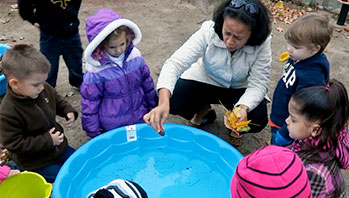- camera or cell phone with camera
- clipboards
- food coloring (2–3 colors)
- markers
- paper
- plastic bottles (several, clear, with smooth sides)
- water
- color
- light (n)
- mix
- passes
- shade
- transparent
MA Draft Standards:
Physical Science/Energy/PS4.D: Compare and sort materials into those that allow all, some, or no light to pass through them. [Cause and Effect]
Head Start Outcomes:
Logic and Reasoning/Reasoning and Problem Solving: Recognizes cause and effect relationships.
Science Knowledge/Scientific Skills and Method: Uses senses and tools, including technology, to gather information, investigate materials, and observe processes and relationships.
PreK Learning Guidelines:
Science and Technology/Inquiry Skills 3: Identify and use simple tools appropriately to extend observations.
English Language Arts/Language 2: Participate actively in discussions, listen to the ideas of others, and ask and answer relevant questions.
Explore Together (outdoors): Colored Light

© Commonwealth of Massachusetts, Department of Early Education and Care. All rights reserved.
STEM Key Concepts: There are many different colors; A color can have many different shades (from very light to very dark); Objects appear to be a different color when viewed throughout a transparent colored material; The color of a light looks different after passing through a transparent colored material
ELA Focus Skills: Follow Directions, Speaking and Listening, Vocabulary
Educator Prep: Fill several plastic bottles with water. Add a few drops of food coloring to each, one bottle for each color. Leave a few bottles filled with clear water.
Children will explore what happens to light when it is cast through different transparent objects.
- Show the bottles of colored and uncolored water to children and ask them to compare the colors and describe the color of water in each bottle.
- Then tell children, Today we are going to go outside to explore what happens to the color of light when it passes through the transparent bottles. Review that a transparent material is something you can see through.
Bring children outside and place the bottles on the ground in the sun. Focus on one bottle of colored water and point to the light cast through the water. Ask,
- What happens to the light that passes through the bottle?
- What do you think will happen if you put your hand in the colored light?
- Ask a volunteer to put his or hand in the light and describe what happens.
- Ask children what they think will happen if they look at an object (such as a leaf) through the red water. Have them observe the leaf and then describe the color of the leaf. Encourage them to be creative when describing the color, such as It looks red-orangey! Revisit and talk about when children mixed red and yellow food coloring.
- Repeat with the bottle of clear water. Invite them to predict what might happen to the color of an object viewed in the light that passes through the water.
Allow children to work in small groups to freely explore looking at objects through the clear and colored water bottles. Have children dictate or draw to document their findings. If you have a camera or video, you may want to take pictures of children's explorations. Prompt groups if needed with questions such as,
- What do you think would happen if you looked at the leaf through the blue bottle of water?
- What if you looked at the leaf through both the red and orange bottles at the same time?
Reflect and Share Together
Invite children to share some of the observations they made with the bottles of colored and clear water.
- Encourage them to use their drawings and recording as they describe what they observed. Ask questions such as,
- Josh, when you put your hand behind the red bottle, what color did it look like?
- Encourage children to think beyond the activity. Say, How could you have made the shade of red darker?
Take It Further: For groups with children of varying ages, you may wish to talk with older children about the several meanings of the word light—a soft shade of a color (light blue); a source of brightness (sunshine and lamps); the opposite of heavy. Explain that because some words have more than one meaning, other words in a sentence give clues to which meaning is being used. Read these sentences and have children tell which light you mean: I added white paint to get a light green. Please turn on the light. This box of toys is light.
